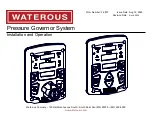
Alarms and Troubleshooting
3-18
Puritan Bennett 540™ Ventilator User’s Manual
HIGH EXH VOLUME
Adjustment of the High VTE level too low.
Under the guidance of a Clinician modify
the High VTE level.
Inappropriate patient circuit.
Replace the patient circuit.
Expiratory flow sensor not calibrated
properly.
Calibrate the expiratory flow sensor (refer
to section
).
Defective expiratory flow sensor.
Replace the exhalation block and calibrate
the expiratory flow sensor (see section
8.1, “Replacing the Air Inlet Filter,” on page
8-1
). Call your customer service
representative.
HIGH INSP VOLUME
Adjustment of the High VTI level too low
(for PSV/CPAP, PRES A/C, PRES SIMV and
VOL SIMV modes).
Under the guidance of a Clinician and
modify the High VTI level.
Adjustment of the pressure level too high
for the volume required (for PSV/CPAP,
PRES A/C, PRES SIMV and VOL SIMV
modes).
Under the guidance of a Clinician and
modify the pressure level.
Leak in the patient circuit.
Check and properly connect the patient
circuit.
Inappropriate patient circuit.
Replace the patient circuit.
Defective flow sensor or internal leak in the
machine.
Have a qualified technician replace the
defective component(s) and call your
customer service representative.
HIGH MINUTE VOLUME
Adjustment of the High Min Vol level
too low.
Under the guidance of a Clinician modify
the High Min Vol level.
Leak in the patient circuit.
Check and properly connect the patient
circuit connections.
Inappropriate patient circuit.
Replace the patient circuit with an
appropriate one.
Defective flow sensor or internal leak of the
machine.
Have a qualified technician replace the
defective component(s) and call your
customer service representative.
HIGH PRESSURE
Adjustment of High PIP too low (only for
VOL A/C and VOL SIMV modes).
Under the guidance of a Clinician increase
the High PIP threshold.
Airway obstruction.
Check patient’s trachea and clear the
obstruction. If the filter is obstructed,
replace the filter.
Proximal pressure tube or patient circuit
obstructed.
Clean the proximal pressure tube or the
patient circuit or replace them.
Coughing or other high-flow expiratory
efforts.
•
Silence the alarm, if necessary.
•
Treat patient’s cough.
Patient inspiratory resistance or
compliance changes.
Have physician determine new ventilator
settings.
Defective internal circuits of the machine or
pressure sensor.
Replace the ventilator and call your
customer service representative.
Table 3-2.
Alarms and Corrective Actions (Continued)
Alarm Message or
Symptom
Possible Reason(s) For The Alarm Event
Corrective Action(s)
Содержание Puritan Bennett 540
Страница 1: ...Puritan Bennett 540 Ventilator User s Manual...
Страница 6: ...This page intentionally blank...
Страница 8: ...This page intentionally blank...
Страница 10: ...This page intentionally blank...
Страница 80: ...Installation and Assembly 4 20 Puritan Bennett 540 Ventilator User s Manual This page intentionally blank...
Страница 86: ...Operating Procedures 5 6 Puritan Bennett 540 Ventilator User s Manual This page intentionally blank...
Страница 94: ...This page intentionally blank...
Страница 100: ...Routine Maintenance 8 4 Puritan Bennett 540 Ventilator User s Manual This page intentionally blank...
Страница 118: ...Specifications A 18 Puritan Bennett 540 Ventilator User s Manual This page intentionally blank...
Страница 123: ...Puritan Bennett 540 Ventilator User s Manual C 3 Figure C 2 Dual Bag...
Страница 124: ...Unpacking and Preparation C 4 Puritan Bennett 540 Ventilator User s Manual This page intentionally blank...
Страница 134: ...Glossary F 6 Puritan Bennett 540 Ventilator User s Manual This page intentionally blank...
Страница 140: ......
















































